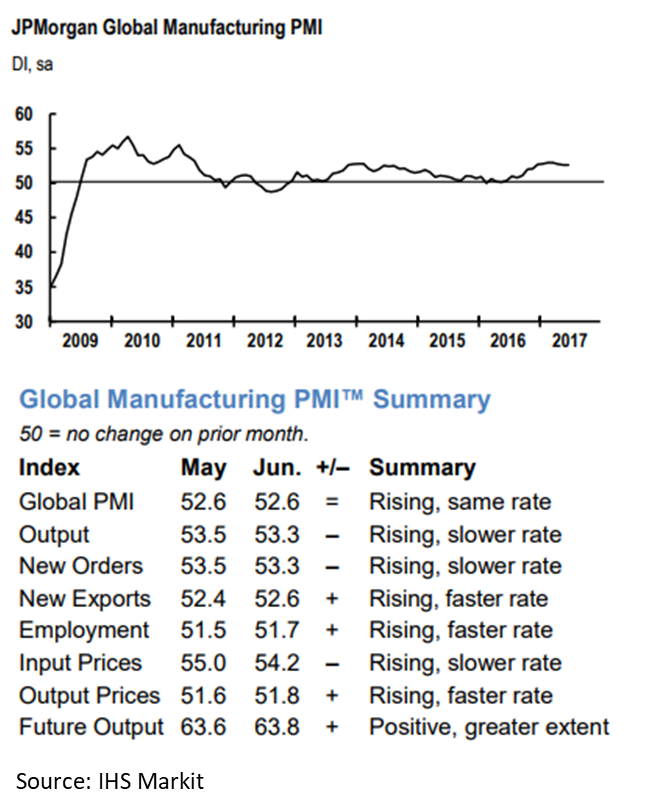Economy

Global Manufacturing Holds Steady in June
Written by Sandy Williams
July 3, 2017
Manufacturing growth remained steady in June, according to the JP Morgan Global Manufacturing PMI. The composite index was unchanged from May at 52.6. The PMI average for second quarter fell slightly below first quarter.
The Eurozone drove growth in June, accelerating the PMI for the region to its highest level in more than six years. Expansion eased in the U.S., Japan and United Kingdom. China led the emerging nations in manufacturing gains during June.
Global production and new orders softened during the month to a slower growth rate. New export orders jumped slightly, pressuring capacity and resulting in higher employment levels.
“The Global Manufacturing PMI was unchanged in June and continues to point to solid, steady gains in global industry at mid-year,” said Joseph Lupton, Global Economist at JP Morgan. “At the same time, firming new orders and broadly based production gains across consumer goods and business equipment suggest factory output is well supported heading into the second half of the year.”
Eurozone
Manufacturing growth hit a 74-month high in the Eurozone in June. The PMI registered 57.4, up from 57.0 in May. The region saw its best average reading for second quarter (57.0) in more than six years with growth strongest in Austria, Germany, and the Netherlands. Spain was the only nation in the region without a PMI increase in June, but continued in expansion territory with a score of 54.7.
Strong domestic demand and new import orders boosted production and increased purchasing activity during the month. Cost inflation eased, especially for inputs, but overall remained above historical average.
“There’s no sign of the impressive performance ending any time soon,” said IHS Markit chief business economist Chris Williamson. “Optimism about the year ahead has risen to the highest for at least five years, backlogs of orders are building up at the fastest rate for over seven years and factories are reporting near-record hiring as they struggle to deal with the upturn in demand. As such, the manufacturing sector is clearly in expansion mode and looks poised for continued robust growth in the coming months.”
China
The Caixin China General Manufacturing PMI moved out of contraction to post a score of 50.4 in June. A marginal increase in new orders, domestically and abroad, boosted production enough to strengthen the composite score. Inventories of raw and finished stocks declined as companies exerted caution in purchasing activity to match subdued demand. After declining slightly in May, average input costs and output charges rose slightly. Backlogs increased as manufacturers trimmed staff. The future business outlook fell to a six-month low.
“The manufacturing sector recovered slightly in June, but based on the inventory trends and confidence around future output, the June reading was more like a temporary rebound, with an economic downtrend likely to be confirmed later,” commented Dr. Zhengsheng Zhong, Director of Macroeconomic Analysis at CEBM Group.
South Korea
With South Korea making headline news over trade deficits with the U.S., manufacturers saw modest growth in domestic manufacturing. Export orders improved to Japan, the Middle East, and the U.S., but were offset by lower demand from China. The Nikkei South Korea Manufacturing PMI registered 50.1, nearly stagnant but moving out of contraction for the first time in 12 months. South Korean firms expect better economic performance and external demand in the coming months. The future outlook survey revealed the strongest degree of confidence since April 2016.
“Whilst hinting of potentially brighter times to come, the latest data nonetheless remain consistent with ongoing stagnation of industrial production,” said Paul Smith, Senior Economist at IHS Markit. Moreover, there remain some headwinds to growth emanating from the direction of China. Ongoing diplomatic tensions continue to undermine bilateral trade relations between the two nations, leading to further falls in new export orders to South Korea’s manufacturers.”
Russia
The Russia Manufacturing PMI posted slightly lower than May at 50.3, but continued a sequence of 11 months of growth. New orders increased modestly, adding to production gains. Export demand continued to weaken and fell at the fastest rate yet in 2017. Input prices were higher due to increases in raw material costs, which were then passed through to factory gate prices. IHS Markit analyst Sian Jones commented that June’s PMI confirmed a loss of momentum in the sector, which “bodes ill for growth throughout the rest of the year.”
Mexico
Manufacturing in Mexico showed a solid rise in production and new orders in June. The PMI rose to 52.3 from 51.2 in May for its strongest improvement in 13 months. Survey respondents reported an uptick in underlying demand conditions along with new product launches and greater investment spending. Employment levels were boosted as firms expanded capacity in anticipation of continued order and output growth. Optimism was high for future business conditions and recovery of export sales.
Canada
The IHS Markit Canada Manufacturing PMI continued to soften in June after hitting a six-year peak in April. The PMI registered 54.7 compared to 55.1 in May. A slowdown in new order volumes and softer job creation contributed to the PMI decline. Production volumes grew slightly in June extending an eight-month streak of growth. Although the domestic market weakened somewhat in June, new export sales, especially from U.S. clients, grew to its strongest pace since November 2014. Manufacturers are optimistic that overall conditions will continue to improve over the next 12 months.
United States
Manufacturing was subdued in June, according to survey data from IHS Markit. The PMI slipped 0.7 points to 52.0. Output and new orders slowed and offset purchasing gains for pre- and post-production inventories. Employment growth eased to its lowest level since March.
Commenting on the final PMI data, Chris Williamson, Chief Business Economist at IHS Markit said: “Manufacturers reported a disappointing end to the second quarter, with few signs of growth picking up any time soon. The PMI has been sliding lower since the peak seen in January and the June reading points to stagnation – at best – in the official manufacturing output data. The survey’s employment index meanwhile suggests that factories will make little or no contribution to non-farm payroll growth in June. Forward looking indicators – notably a further slowdown in inflows of new business to a nine-month low and a sharp drop in the new orders to inventory ratio – suggest that the risks are weighted to the downside for coming months. Any good news was saved for inflation, with price pressures easing substantially in June on the back of waning global commodity prices.”

Sandy Williams
Read more from Sandy WilliamsLatest in Economy

Steel groups welcome passage of budget bill
Steel trade groups praised the passage of the Big Beautiful Bill (BBB) in Congress on Thursday.

Industry groups praise Senate for passing tax and budget bill
The Steel Manufacturers Association and the American Iron and Steel Institute applauded the tax provisions included in the Senate's tax and budget reconciliation bill.

Chicago PMI dips 0.1 points in June
The Chicago Purchasing Managers Index (PMI) slipped 0.1 points to 40.4 points, in June.

Multi-family pullback drives housing starts to 5-year low in May
US housing starts tumbled in May to a five-year low, according to figures recently released by the US Census Bureau.

Architecture firms still struggling, ABI data shows
Architecture firms reported a modest improvement in billings through May, yet business conditions remained soft, according to the latest Architecture Billings Index (ABI) release from the American Institute of Architects (AIA) and Deltek.

